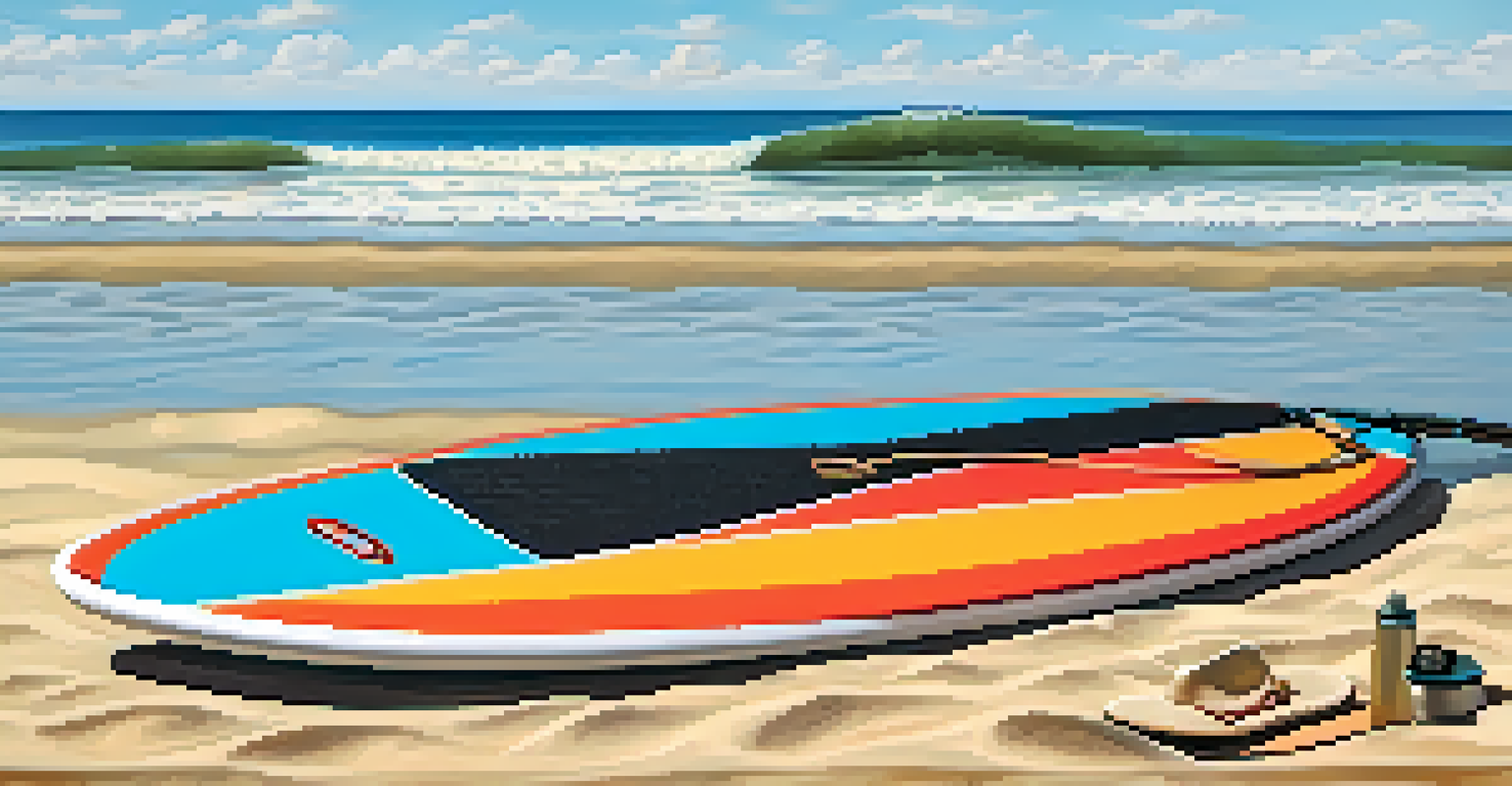Stand-Up Paddleboarding Safety Guidelines for Beginners

Understanding the Basics of Stand-Up Paddleboarding Safety
Before you hit the water, it's crucial to understand the basics of stand-up paddleboarding (SUP) safety. Knowing how to maintain balance and paddle effectively can make all the difference in your experience. This foundational knowledge not only enhances your enjoyment but also minimizes risks associated with falling in the water.
Safety doesn't happen by accident.
Another important aspect is being aware of your surroundings. Always keep an eye out for other paddlers, boats, and potential obstacles. This vigilance helps you navigate safely and avoid accidents, especially in busy waterways where multiple activities may be occurring.
Lastly, familiarize yourself with the potential hazards in the area you plan to paddle. This includes currents, tides, and weather changes. By understanding these factors, you can make informed decisions that ensure a safer and more enjoyable outing.
Choosing the Right Equipment for a Safe Experience
Selecting the right equipment can significantly enhance your safety on the water. Start with a stable paddleboard that fits your height and weight, which can help you maintain balance. A wider board is often recommended for beginners as it provides more stability, making it easier to stay upright.

Don't forget about the paddle! A properly sized paddle is essential for efficient paddling and can help prevent fatigue. When choosing a paddle, make sure it's about 6-8 inches taller than you when standing, allowing for a comfortable reach and effective strokes.
Prioritize Safety Before Paddling
Understanding basic safety skills, equipment, and local regulations is essential for a safe and enjoyable paddleboarding experience.
Finally, always wear a personal flotation device (PFD). Even if you’re a strong swimmer, unexpected situations can arise. A PFD not only keeps you safe but also provides peace of mind, allowing you to focus on enjoying your time on the water.
Checking Weather Conditions Before Paddling
Before you embark on your paddleboarding adventure, checking the weather conditions is a must. Strong winds, rain, or storms can create dangerous situations for paddlers. Spending a few minutes reviewing the forecast can save you from unexpected challenges and ensure a pleasant outing.
It's not the destination, it's the journey. Enjoy the ride, but always prioritize safety.
Pay attention to the wind direction and speed, as these factors can affect your stability and maneuverability. For beginners, it’s advisable to avoid paddling in winds over 10-15 mph, as this can be particularly challenging. A calm day offers the best opportunity to practice your skills without added stress.
Additionally, keep an eye on local weather alerts. Sudden changes in weather can occur, especially in coastal areas. Being informed allows you to make quick decisions, ensuring that you can safely return to shore if conditions worsen.
Staying Hydrated and Protected from the Sun
Paddling can be a physically demanding activity, so it's essential to stay hydrated. Always bring water with you and take regular breaks to drink. Dehydration can sneak up on you, especially under the sun, impacting your energy levels and focus.
Speaking of the sun, don’t underestimate its power. Apply a high-SPF waterproof sunscreen before you start and reapply it throughout your outing. Wearing protective clothing, such as a hat and UV-blocking sunglasses, can also shield you from harmful rays and keep you comfortable.
Stay Hydrated and Sun-Safe
Maintaining hydration and applying sunscreen can prevent fatigue and sunburn, allowing you to fully enjoy your time on the water.
Remember, even on cloudy days, UV rays can still reach you. Make sun protection a part of your routine every time you paddle. This way, you can enjoy your day on the water without worrying about sunburn or heat exhaustion.
Understanding Local Laws and Regulations
Every waterway has its own set of laws and regulations that paddlers must adhere to. Familiarizing yourself with these rules can prevent potential fines and ensure a smoother experience. Check if you need a permit to paddle in certain areas or if there are specific guidelines for using your equipment.
In some locations, there may be restrictions on paddleboard use during certain times or in specific areas. Knowing these regulations helps you plan your trip effectively and avoid any unwanted surprises. It's always best to be informed before setting out on your adventure.
Lastly, don’t hesitate to ask local paddlers or rental shops for advice. They often have valuable insights about the local area and can provide tips on where to paddle safely. Building a good rapport with the local community can enhance your experience and ensure you stay within the legal guidelines.
Practicing Basic Safety Skills Before Hitting the Water
Before you set out for your first paddleboarding experience, practicing basic safety skills is highly beneficial. Start by learning how to properly fall off your board. Instead of flailing, try to fall away from the board and into the water, which can help prevent injuries.
Another essential skill is getting back on your board after a fall. Practice this in shallow water until you feel confident. Being able to reboard efficiently gives you the freedom to explore without fear of becoming stranded if you slip off.
Paddle with a Partner
Having a buddy while paddleboarding not only enhances enjoyment but also provides an extra layer of safety in case of emergencies.
Lastly, practice paddling techniques on land. Familiarize yourself with proper stances and strokes, as well as turning and stopping. The more comfortable you are with these skills, the more enjoyable your time on the water will be.
Paddling with a Buddy for Enhanced Safety
One of the best safety tips for beginners is to paddle with a buddy. Having a partner not only makes your experience more enjoyable but also provides an extra layer of safety. If something goes wrong, whether it's a sudden fall or a medical issue, having someone nearby can make all the difference.
When you paddle with a buddy, you can look out for each other. This includes keeping an eye on each other's technique and energy levels, ensuring that both of you stay safe and comfortable. Plus, it’s always nice to share the beauty of the water with someone else!

If you’re heading out with a group, establish a plan for communication. Set meeting points and check-in times to keep everyone accounted for. This way, you can fully immerse yourself in the experience, knowing that everyone is looking out for one another.
Knowing When to Turn Back: Listening to Your Body
As you paddle, it’s essential to listen to your body. If you start to feel fatigued or unwell, it’s time to consider heading back. Pushing through exhaustion can lead to poor decision-making and increase your risk of accidents.
Pay attention to signs of dehydration or overheating, such as dizziness or excessive sweating. If you experience any of these symptoms, take a break in the shade and hydrate before continuing. Remember, the water will always be there for another day!
Moreover, if conditions change unexpectedly, don’t hesitate to turn back. Whether it’s a sudden change in weather or feeling uncomfortable on your board, making the decision to return can keep you safe. Trust your instincts and prioritize your well-being above all else.